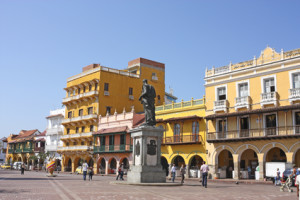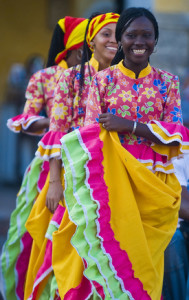Brief History
Colombia is a country that is located on the Northwest tip of South America. It is one of the most colorful countries in the Western Hemisphere. Colombia’s culture has its roots in the collection of the native cultures, such as the Tayrona and the Muisca, and the colonial minded Spain. With the Spanish came African slaves, the caste system, and Catholicism.
 Spain arrived in Colombia in the sixteenth century and brought with them new ways of thinking about the world around them. As the Spaniards and the native cultures cohabitated, many Mestizo, Mulatto, and Moreno children were born. The whites struggled to keep their Spanish culture; however, as time passed it became more and more difficult. The Spanish did, however, instill laws that allowed them to marry close cousins or even siblings in order to maintain their blood and heritage lines. Blacks and indigenous people also came together and produced children which were labeled as Zambos. All these mixed populations, in addition to the new global society of today, has created a fusion of cultures and traditions that has become what is now Colombia.
Spain arrived in Colombia in the sixteenth century and brought with them new ways of thinking about the world around them. As the Spaniards and the native cultures cohabitated, many Mestizo, Mulatto, and Moreno children were born. The whites struggled to keep their Spanish culture; however, as time passed it became more and more difficult. The Spanish did, however, instill laws that allowed them to marry close cousins or even siblings in order to maintain their blood and heritage lines. Blacks and indigenous people also came together and produced children which were labeled as Zambos. All these mixed populations, in addition to the new global society of today, has created a fusion of cultures and traditions that has become what is now Colombia.
Because of the Spanish, many of the indigenous people were destroyed and only about 3.4% of these people remain today; however, the various elements that made up those cultures are very much instilled into the folklore, language, music, and foods of this country.
General Overview
Colombia has some of the richest topography in the world with its main rivers being Caquetá, Cauca, Magdalena, and Guaviare. They have two wet seasons and the temperature can vary from very hot to very cold. Due to its natural structure, the country is divided into six separate natural areas.
July 20, 1810, is celebrated as Independence Day in Colombia, while it would take many more years and many more leaders to be truly independent from Spain and all of the other European nations that were colonizing the New World at that time. Nevertheless, July 20 is seen as the start of that long journey.
Artists and Authors
 Colombians have created their identity through language, art, music, and even the celebrations they have. They are a diverse people who are proud of their history and even more proud of where their country is going in the near future.
Colombians have created their identity through language, art, music, and even the celebrations they have. They are a diverse people who are proud of their history and even more proud of where their country is going in the near future.
Like most of South and Central America, Colombia speaks Spanish. It is through Spanish that many of Colombian authors have been able to speak to the world.
Evelio Rosero is one such writer. He has become one of the most revered and celebrated authors, inside and outside, of Columbia. His book The Armies is a vivid recreation of the Colombian civil war and how it devastated the people of Columbia.
Laura Restrepo is another of Colombia’s celebrated authors. Her novel Delirium is wildly acclaimed as one of the best books that show how violence affects both the society at large, and the individual.
Another way that Colombia expresses itself is through art. There are conservatories and schools that the government nurtures; thereby, encouraging young artists to express themselves and to let the world see the beauty that Colombia has to offer.
One of the most famous artists and sculptors to come out of Colombia is Fernando Botero. Fernando Botero originally went to school to be a bullfighter. His interest quickly turned to the arts and his sculptures, Roman Soldier (1985), Maternity (1989), and The Left Hand (1992), have been exhibited and enjoyed by native Colombians and citizens throughout the world.
Cuisine of Colombia
Food is another area where Colombia shines. The mixture of Spanish cuisine mixed with native flavors have created a unique combination that must be experienced to be believed. The culinary experts in Colombia don’t merely cook food, they are artisans that have honed their craft over many generations. At many of their regional and national festivals such as Campeonato de Voleibol Playa, Fiesta de las Corralejas, and Festival Nacional del Porro, you can sample, not only the food, but all that Colombia has to offer.




